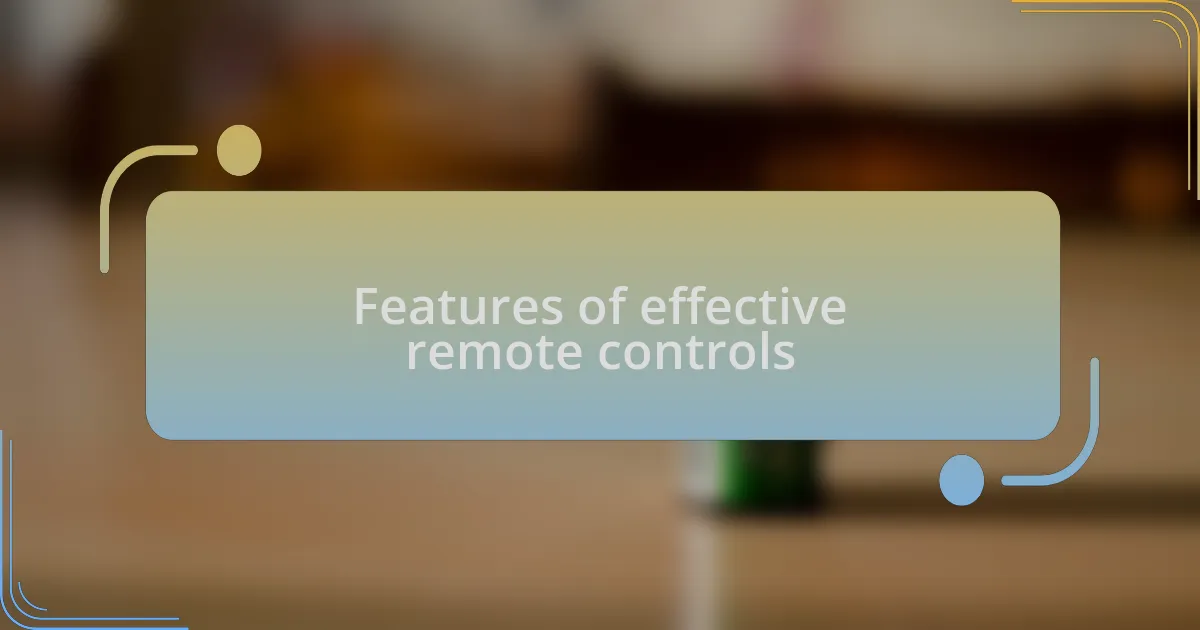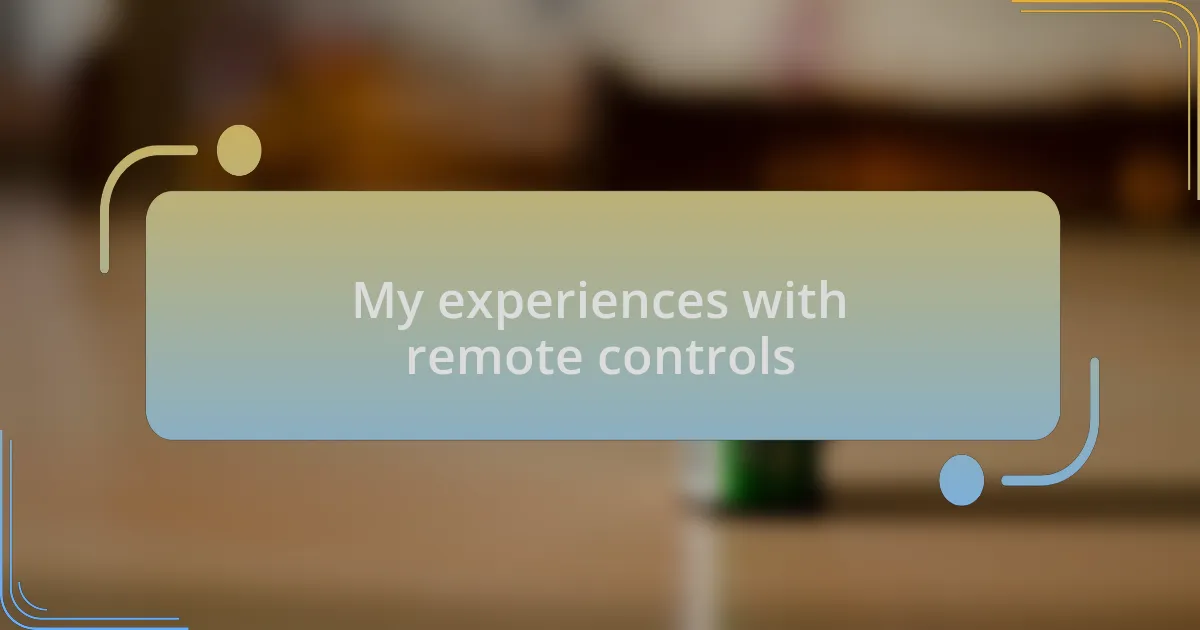Key takeaways:
- Infrared and RF remotes differ significantly in functionality; RF remotes allow operation without a direct line of sight, which is beneficial in complex setups.
- User-friendly interfaces and responsiveness are essential features for effective remote controls to prevent delays and confusion during crucial moments.
- Durability of remote controls is important in production environments, as they often face harsh conditions and possible drops.
- Regular maintenance, familiarization with remote features, and pre-production testing are key practices to enhance workflow and prevent technical issues during filming.

Types of remote controls used
When discussing types of remote controls, I often find myself reflecting on how varied they can be in function and design. For instance, infrared remotes remain a classic choice for many devices, relying on line-of-sight operation. I remember a time using an infrared remote during a live shoot; it was nerve-wracking to ensure the angle was perfect every time to maintain control over the lighting.
More sophisticated options like RF or radio frequency remotes take things a step further, allowing for operation without a direct line of sight. This feature is invaluable during production, especially when managing multiple lights or cameras spread across a large area. Have you ever scrambled to adjust equipment while on set? I certainly have, and these remotes made all the difference, streamlining the process and allowing me to focus more on the creative side of things.
Then there are apps that turn smartphones into remote controls, adding a tech-savvy twist to control. I can’t help but smile when I think about the ease they bring—just a quick tap on the screen and voilà! This modern approach makes it easier than ever to manage any film production setup, but I do sometimes wonder if it’s making us rely too much on our devices rather than honing our hands-on skills.

Features of effective remote controls
When I think about the features of effective remote controls, one standout characteristic is the user-friendly interface. It’s essential that a remote is intuitive, with clearly labeled buttons and a layout that feels natural. I remember getting flustered during a crucial scene when I fumbled with a poorly designed remote—there’s nothing worse than the clock ticking down while you’re trying to find the right function.
Another vital feature is the responsiveness of the controls. A remote should react quickly to commands; there’s a real thrill in seamlessly switching lights or adjusting cameras on the fly. During one shoot, a remote’s lag made editing a headache later on—every delay felt like a small eternity. Have you ever experienced that frustration? You can’t afford any hiccups during a minute of action or a pivotal moment.
Lastly, durability can’t be overlooked. Effective remote controls are built to withstand the rigors of production environments; after all, they’re often dropped or tossed in a bag without a second thought. I recall a day when rain unexpectedly began pouring during an outdoor shoot, and my old remote held up beautifully—it became one less thing to worry about. A robust design not only extends the life of the remote but also brings peace of mind when you’re focused on the creative aspects of filmmaking.

My experiences with remote controls
I’ve had my fair share of experiences with remote controls, which often doubled as a source of unexpected tension on set. There was this one time during a critical scene, right as we were about to capture a dramatic moment, the remote suddenly decided to freeze. The panic I felt in those few moments still lingers; it’s like waiting for a train that’s already late – you know something important is at stake, and every second counts. Have you ever had that feeling of dread while waiting for tech to cooperate?
On another shoot, I came across a remote that had all the bells and whistles: backlit buttons, customizable settings, and a sleek design. I was excited about its possibilities until I realized the learning curve was steeper than I anticipated. I vividly recall spending much of my time fumbling through the manual instead of focusing on the creative process. It’s funny how something designed to simplify can sometimes complicate our workflows—has that ever happened to you?
Durability has also played a significant role in my experiences. I once went to grab a remote only to have it slip from my hand, sending it crashing down onto the hard floor. Instead of panicking, I found comfort in knowing that this remote had survived similar falls before—its resilience became a small victory in the chaos of production. It makes me wonder: how much thought do we actually put into choosing tools that can endure the rigors of our craft?

Tips for using remote controls
When using remote controls, I’ve realized that keeping the device clean is crucial. There’s nothing more frustrating than pressing a sticky button when you’re in the middle of an important scene. I remember a time during a critical shot when I was struggling with a remote that felt like it was coated in years of grime. It became a lesson for me: always have a microfiber cloth handy to maintain your equipment.
Another tip I’ve discovered is the importance of knowing your remote’s features inside and out. I once underestimated a simple function that allowed me to quickly switch camera angles. Instead of fumbling with settings on a touchscreen, using that feature could have saved me precious time. Have you ever experienced that moment of clarity where mastering a tool enhances your workflow remarkably?
Lastly, I can’t stress enough the value of testing your remote controls before filming. There was this one shoot where I assumed everything was working perfectly, only to find the signal dropped intermittently during a scene. If only I had done a quick function check ahead of time! I learned that a little pre-production preparation can prevent a lot of headache on set. Wouldn’t you agree that taking those extra minutes can save hours of frustration later?